The Last Sears in New England
There are barely a dozen Sears stores still in operation. I visited the last one in New England. This is what I saw...
Happy Sunday and welcome to another edition of Willoughby Hills!
In case you missed it, I recently renamed Quarantine Creatives to Willoughby Hills. This newsletter will continue to explore topics like history, culture, work, urbanism, transportation, travel, agriculture, self-sufficiency, and more, just under a new name.
If you enjoy what you’re reading, you can subscribe to have this newsletter delivered to your inbox twice a week (it’s free):
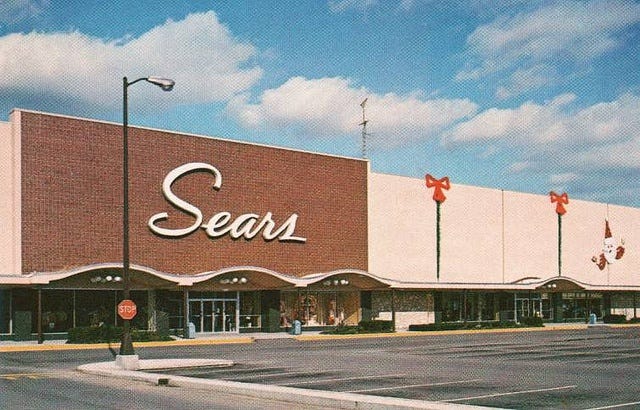
I have some big news to share with you, dear reader. I recently went to Sears!
Not that long ago, visiting Sears would have been considered mundane, routine, boring. At its peak, there were more than 3,500 locations across the country (this count includes both Sears and K-Mart stores, which purchased Sears in 2004).
As recently as 2018, there were still about 700 locations still in operation when the chain declared bankruptcy. Over the last five years, nearly all of those locations have closed.
Today, visiting a Sears store is a novelty that is available to very few people. There are just over a dozen main line Sears left in the world, plus a few small format Sears Home & Life stores and two Appliance and Mattress locations. A location in Washington closed last month, and it’s unclear how much longer the entire business can survive.
One of the last remaining stores happens to be in Braintree, Massachusetts, not far from where I live. I stopped by and was shocked to see how far this retailer that once dominated America had fallen.
In 1886, Richard Sears began selling watches, soon joined by watch repairman Alvah C. Roebuck. Their first catalog was published in 1896, and it became a vital supplier for America’s largely rural population at the turn of the last century.
Sears began operating retail stores in 1925, mostly in urban areas. In the 1950s and 1960s, Sears was one of the first department stores to begin opening shops in the suburbs. Their headquarters in Chicago’s Sears Tower opened in 1973 and was once the tallest building in the world. (Sears left downtown Chicago in 1988 and the building has since been renamed Willis Tower.)
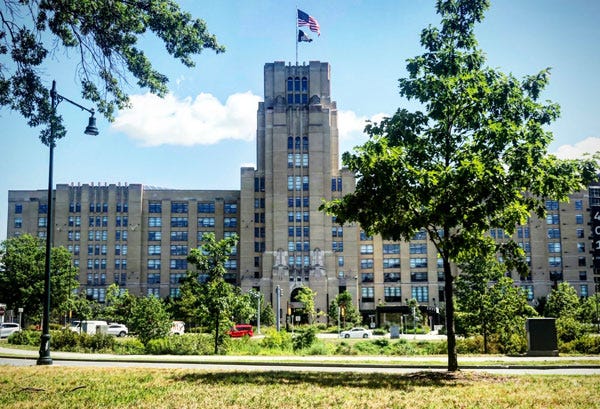
Brands like Allstate Insurance, the Discover card, and Craftsman tools began within Sears and were later spun off into separate businesses.
My grandparents’ home for more than 40 years in Willoughby, Ohio was a kit home sold by Sears. Imagine a piece of IKEA furniture that you assemble yourself. Sears used to sell houses that way!
My grandpa’s neighbor built the house known as a “Gladstone” in 1930. According to an ad for this style house from a 1916 Sears catalog:
“For $884.00 we will furnish all the material to build this Six-Room House, consisting of Lumber, Lath, Flooring, Ceiling, Siding, Finishing Lumber, Shingles, Mill Work, Building Paper, Pipe, Gutter, Sash Weights, Hardware and Painting Material. NO EXTRAS, as we guarantee enough material at the above price to build this house according to our plans.”
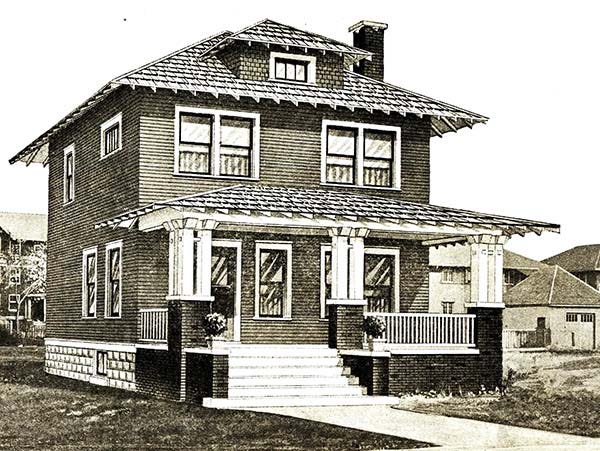
My grandpa also worked a second job at a local Sears store for many years. My mom remembers buying most of her clothes there as a girl because of his discount.
The Sears in Braintree, Massachusetts opened at the South Shore Plaza mall in 1980 and is now the last surviving Sears in New England (the next closest store is in New Jersey).
Approaching from the parking lot, the store actually looks inviting and relatively modern. The entrance is surrounded by a stone facade and the refreshed logo feels clean. If I hadn’t been following the news for the last decade or so, I might think this was a thriving store, or at least as thriving as a mall department store can be in 2023.
This exterior refresh happened in 2016, but it was actually done to conceal the fact that this Sears was shrinking. This location was once three stories tall (two stories plus a basement). Sears subdivided the space, leasing the top floor of the store to Irish apparel retailer Primark.
(Ironically, Primark also occupies the site of the former Filene’s department store in Downtown Boston, which I wrote about here).
Here’s how the newly divided store looks from inside of the mall:
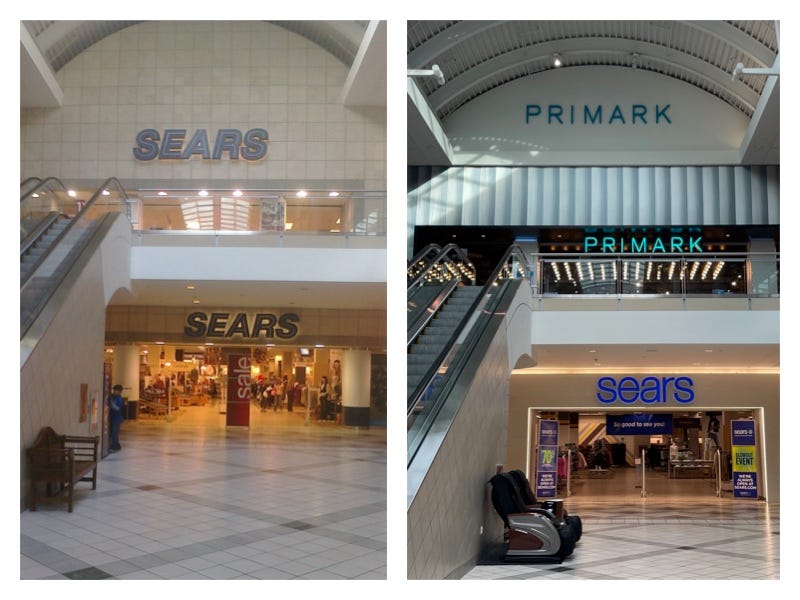
Primark was fully renovated and there is no sign that it was ever a part of Sears, yet on the Sears level, little has changed. Entering the store, I couldn’t figure out why there was what seemed like a temporary construction wall in the middle of the floor. It took me a moment to realize that the old escalators had been covered with drywall.
I’m not sure why the escalators were retained. Perhaps there was hope that Sears fortunes would turn around and they could one day occupy their full store again. More likely, it was considered too costly to remove the escalators, so a wall was built to contain them.
When coming through the mall entrance, I found myself in the women’s department. The clothing in this area was quite plain, mostly solid colors. There weren’t many styles either- just large quantities of very similar shirts.
After walking through the women’s department, I came upon the shoe section. A lot of the shelving, especially around the perimeter, was completely bare. The kids’ shoe section was completely bare.
It felt like a store half-way through a liquidation sale. It didn’t help that there were rows upon rows of identical boots with a hand-written sign advertising the price, similar to how a store looks when it is going out of business.
The “final sale” vibe continued in the girls’ department. The only clothing that seemed to be in stock for girls were hundreds of winter coats in maybe half a dozen designs. Literally every available rack and shelf was just coats, and they were priced at $12.89. (The boys’ department was also nothing but coats.)
The men's department had a bit more variety than other areas of the store, but its shelves were also pretty sparse. It was the one department where I noticed signage for a name-brand, Lee jeans, but I didn’t get a close look at the jeans for sale to see if they were actually Lee brand or if the signs were just old and had just never been taken down.
The basement level of the store, where appliances, mattresses, and hardware were for sale looked a little fuller than the upstairs clothing level.
I noticed several name brand appliances for sale, including washer/dryers, stoves, and refrigerators, although I wonder who would opt to purchase an appliance from a store that may be out of business before the item can be delivered.
The mattress section felt the most complete and did not give the impression that the store was in any financial trouble.
The hardware department in Braintree appeared to be exclusively Craftsman tools, and was mostly socket wrenches, screwdrivers, and a few tool boxes and workbenches. It would be hard to complete a project with the limited stock they had.
In the era before Home Depot and Lowe’s, the Sears hardware department was second to none. Craftsman hand tools carried a lifetime warranty. In 1989, Bob Vila gave up his job hosting This Old House to become a Sears spokesperson.
The Craftsman brand was sold to Stanley Black and Decker in 2017, making tools under that name available at places like Lowe’s and Ace Hardware. The agreement allowed Sears to make and sell some Craftsman tools. (Stanley settled a lawsuit with Sears in 2019 for breach of contact around this issue).
The tool department was a shadow of what it once was, with much of the floor space now being used as a stockroom for boxed appliances and appliance accessories like electrical cords and dryer vent pipes. There were no power tools, lawn mowers, or anything like that in sight.
The basement also used to house a Sears Auto Center, which closed along with all other remaining locations about a year ago. The sign outside the building still advertises its services. The garage bay windows have been papered over, but it otherwise is hard to tell that the location is no longer in operation.
As I was touring this Sears, my thoughts kept going back to my grandpa. He was an employee and consumer, and lived in a Sears house for most of his adult life. I still regularly use some of his tools that are Craftsman brand.
But the memory that felt the most relevant as I walked through this store was actually the feeling I had when watching my grandpa die.
My grandpa unexpectedly collapsed one day and was taken to the ER. By the time I got there to visit him, he was on a ventilator and was no longer able to talk. It was still him, but yet, it wasn’t. Much like this Sears store.
He was moved to a hospice room and had morphine administered and the ventilator removed, which made him fall asleep. He was still breathing a little bit on his own, and would flinch when he heard certain voices, but it was obvious that his time was growing short. On paper, he was still “alive” for a few more days, but nobody expected a recovery.
I felt that same energy walking around this Sears. It was breathing, but it was barely alive.
The strange thing to me is that the store didn’t quite seem resigned to its own fate yet. In fact, it still was trying to masquerade as a fully functioning department store. There were professionally printed signs near the escalator encouraging people to apply for jobs, as though the location was gearing up for a busy shopping season. The signs offered “full-time and part time positions,” plus “career advancement opportunities.”
At one of the registers there was still a display of gift cards for sale. I wondered who would give these as a gift and to whom? Would the gift card hold any value a week or a month from now? And would the recipient even have a Sears location near them to redeem the card?
Contracting from 700 stores a few years ago to about 15 today is a drastic shift. I wondered if there was still anybody at the corporate offices keeping these stores going. Who was ordering the merchandise? Was there anybody sending out paychecks? Who was designing the gift cards and in-store signage? If those corporate jobs did exist, could the revenue of these handful of scattered stores support that overhead?
At this point, I can’t understand why Sears continues to hold on at all, but I’m also confused why these particular stores are the ones that remain. They are scattered on the West Coast, the East Coast, and even in Puerto Rico and Hawaii. There seems to be no rhyme or reason to which stores have survived and which ones have perished.
Ben Unglesbee explored the complexities of keeping a store open in a piece for Retail Dive, but he didn’t find any obvious answers to the question either.
At the end of the day, walking through this half empty store with its eclectic mix of random merchandise felt like I had asked an AI program to create a department store and this Sears is what it came back with. The general look and feel was largely correct, but the details were all wrong.

I had gone in to touring this holdout Sears location hoping to be flooded with a wave of nostalgia. I was imagining feeling wistful about buying my first drill at a Sears with my dad or remembering taking pictures at the Sears Portrait Studio. Instead, I was pretty repelled by the whole experience.
As I went to leave Braintree, there was a sign on the exit door that felt oddly threatening. It said “This isn’t goodbye.” At most other retailers, I would read that as a tongue in cheek joke and it might make me smile a bit. At Sears, it felt like a scary denial.
Even if the world is ready to declare them dead, it seems that Sears has decided to fight until the last moment. To what end, I’m not quite sure. No matter what the sign on the exit may say, I suspect this is goodbye.
I’d love to hear your thoughts- please drop a comment below!
Related Reading
A Cleveland Dead Mall Christmas
The Many Incarnations of Toys R Us
If you’ve missed past issues of this newsletter, they are available to read here.
If you enjoyed this issue, please share forward it to a friend or share it on social media:
Stay Safe!
Heath


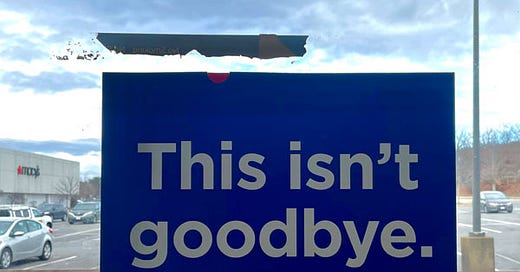


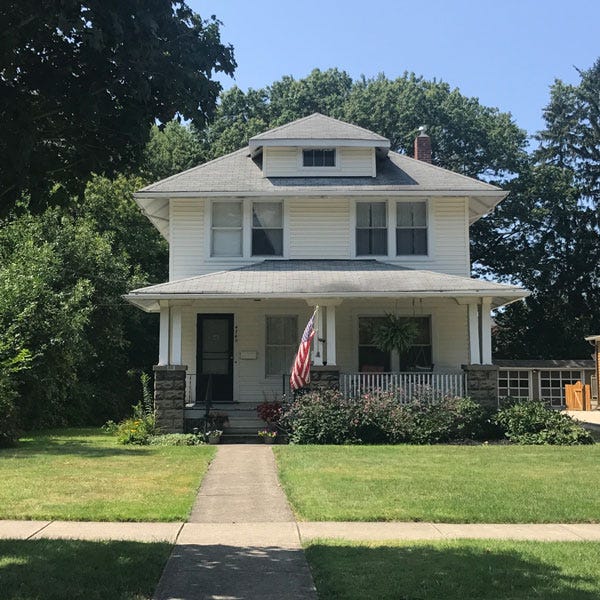
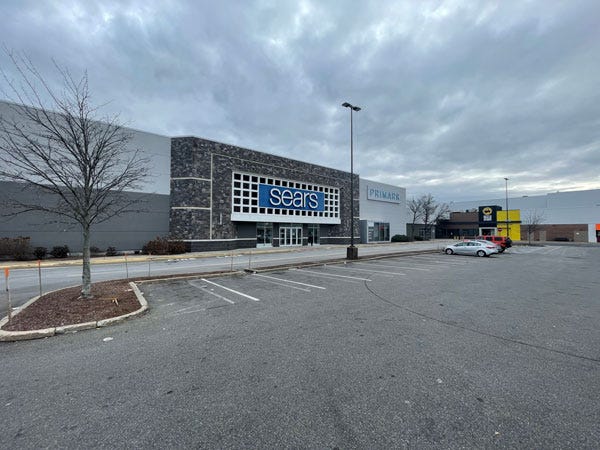
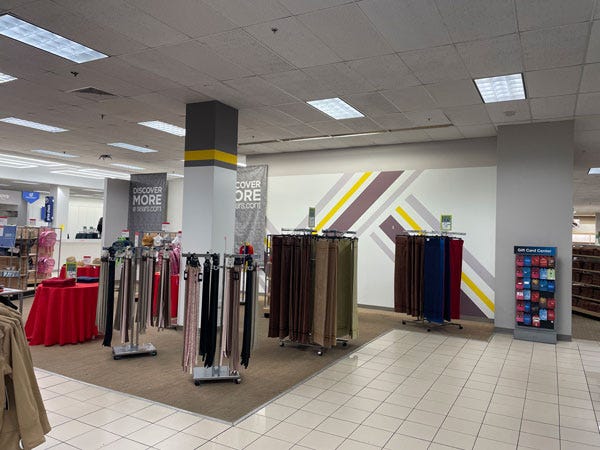

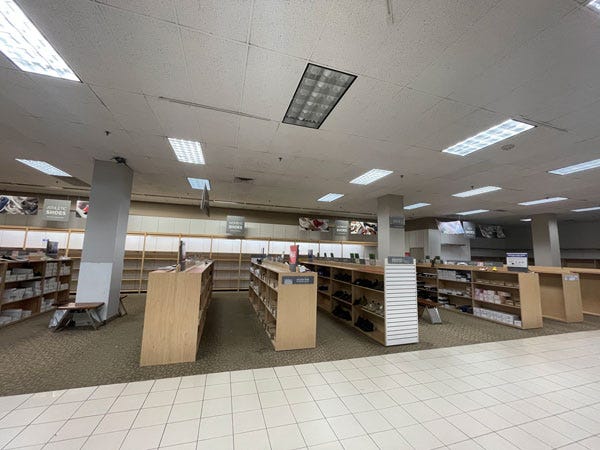
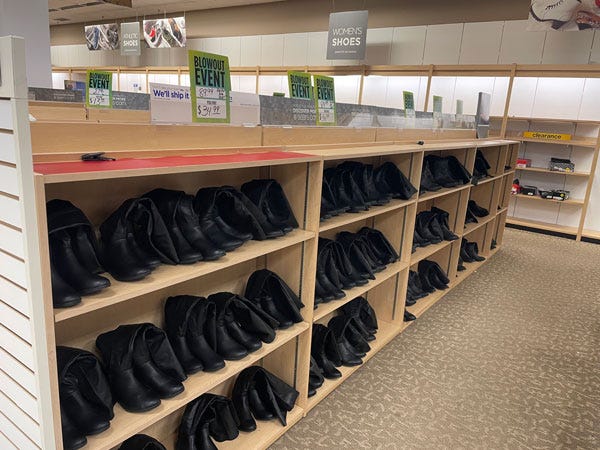
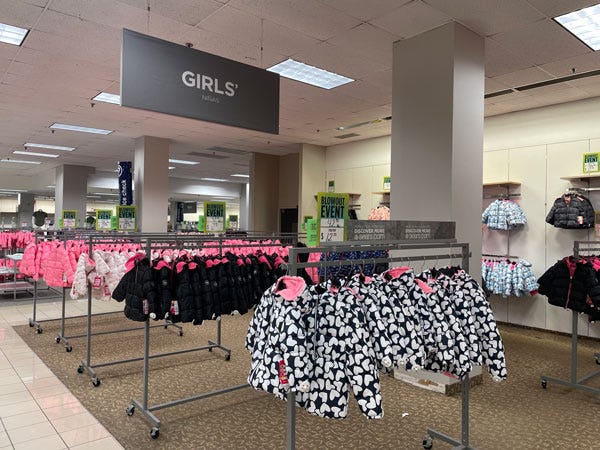
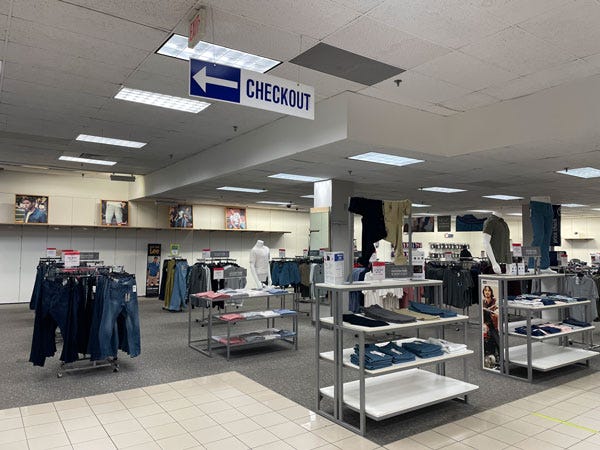
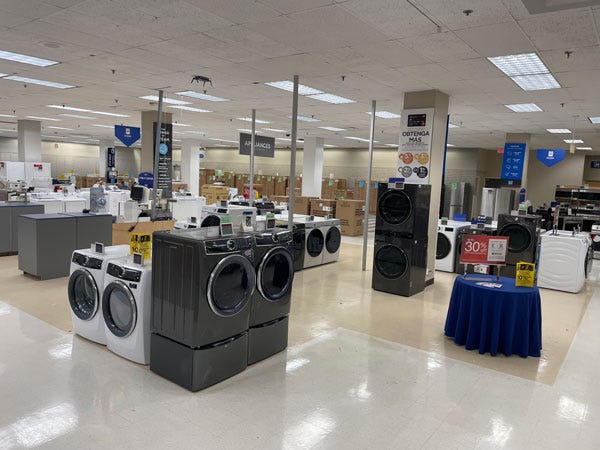
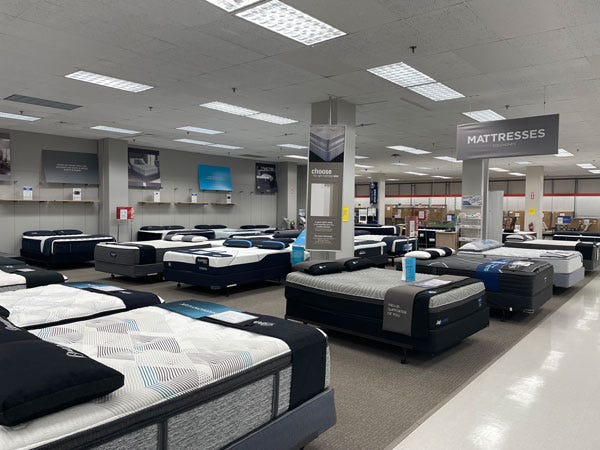



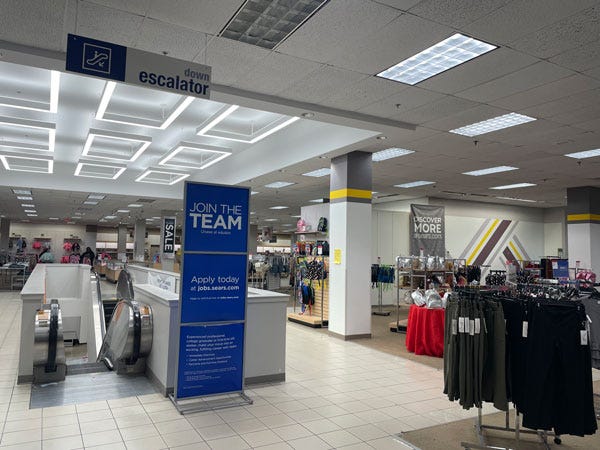
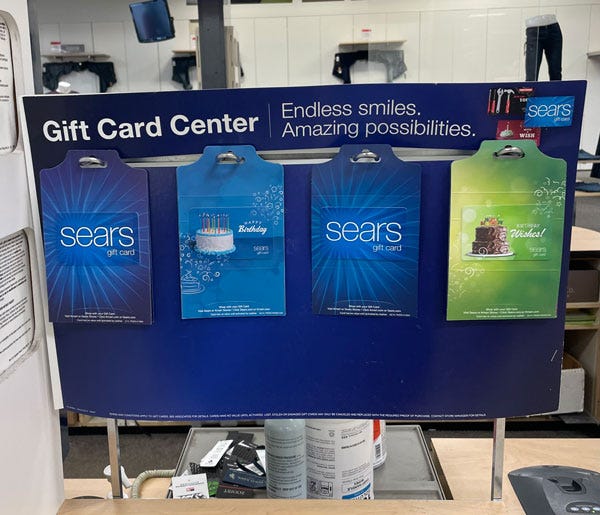
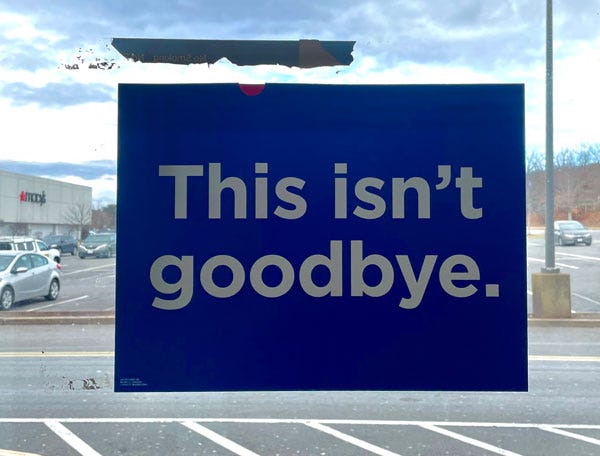
I worked for a Sears Catalog Surplus (later Catalog Outlet) store for ten years, until 1989 ... shortly before they closed catalog down. That is when they lost their soul ... that catalog had EVERYTHING, and was a fabulous marketing tool - every house had one. When they shut down catalog (supposedly because they didn't want to pay future pensions for upcoming retirees; the catalog department was on target to be profitable after losing money for a few years) Sears became just another store. A store with great policies (employees may remember Bulletin O-277 - defining what it meant by Satisfaction Guaranteed) but even those would be gone soon. A REAL shame ... just prior to that, Sears was still the #1 retailer in the world. I have great memories still of working for Sears.
Sears was our big family supplier late 60s-70s.
1. I remember the see dishwasher with the see trough front. My parents said they could set our strollers in front of it and keep us occupied watching
2. also the ball suspended on the stream of air from the vacuum cleaner on reverse. Another baby/toddler entertainment
3. My parents kept a legal pad with Sears catalog items to order. At least six columns with all the details necessary to call in the order. Seemed to take forever to dictate the order. including options, color, shipping weight.
4. Which then leads me to picking up the Sears order, which was usually a nightmare. Took forever. "Maam, are you being helped?" "Well, I handed my order # to someone and they went in the back, but that was 20 minutes ago"
5. Turquoise colored vans always in the neighborhood with deliveries or repairs
6. A vague memory of there being some mystery to what we were picking up. I guess backorders maybe. "Well lets go see what this order they called us about is"
7. The catalogs were great. I remember spending hours with the Wishbook, the general catalog and even a reproduction of an old catalog.